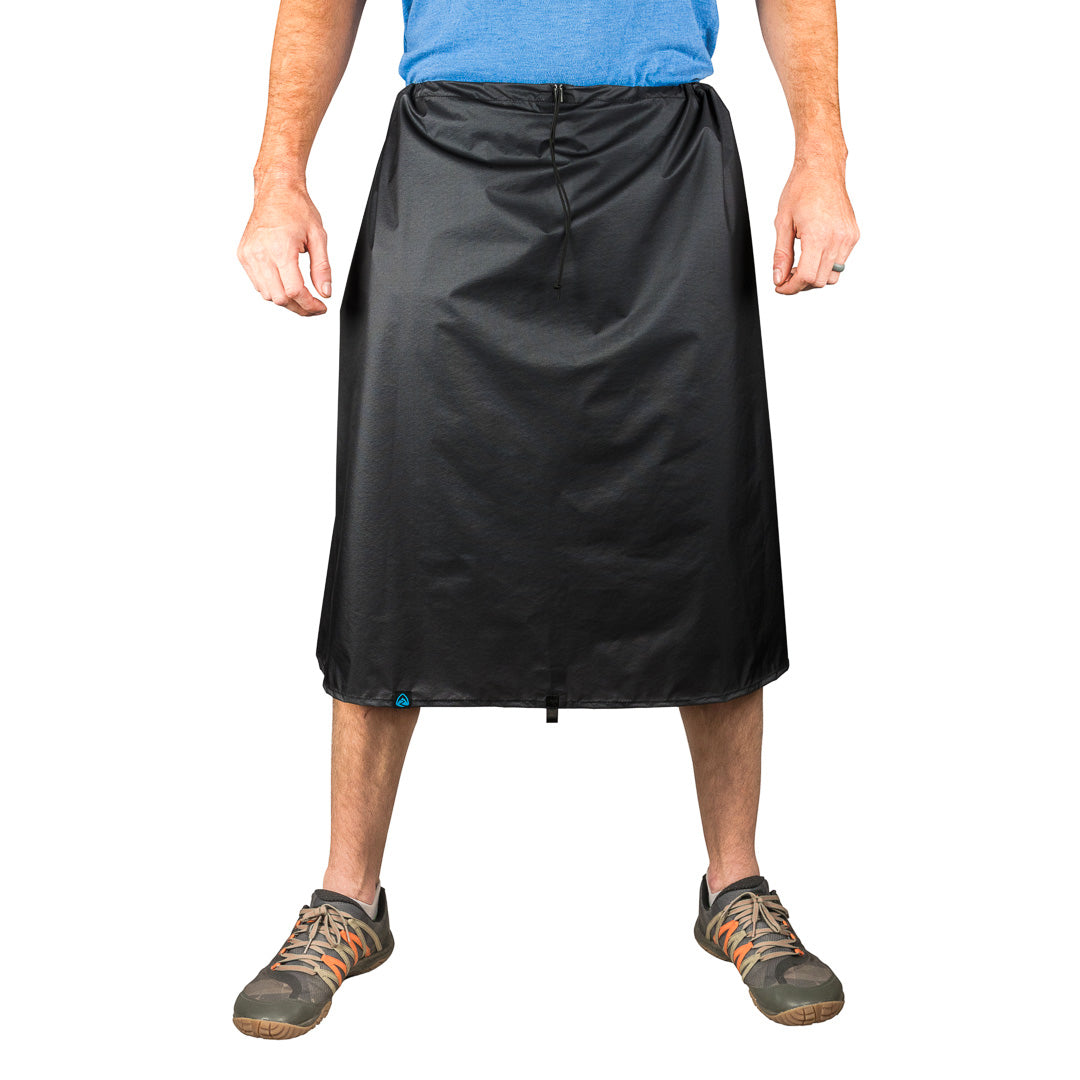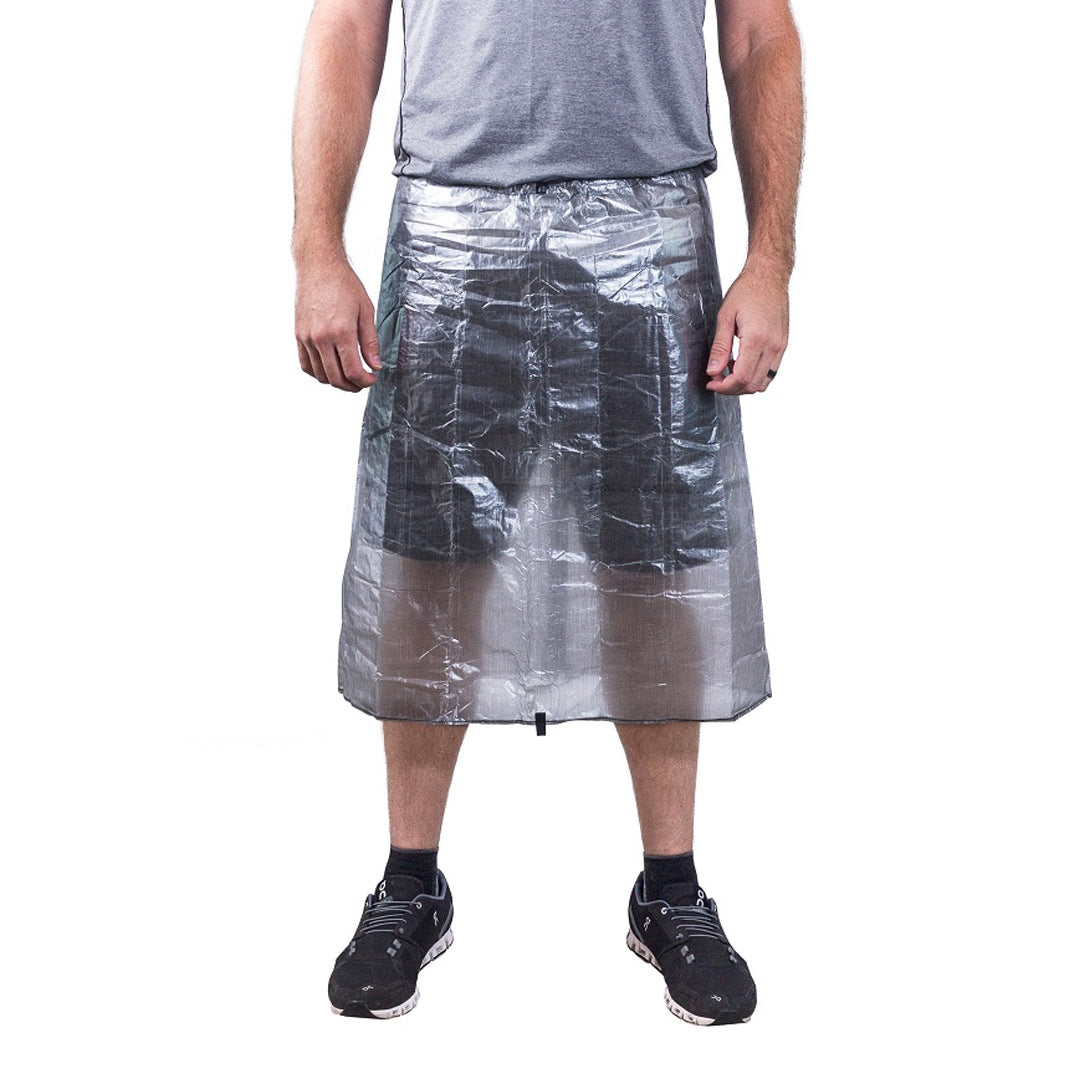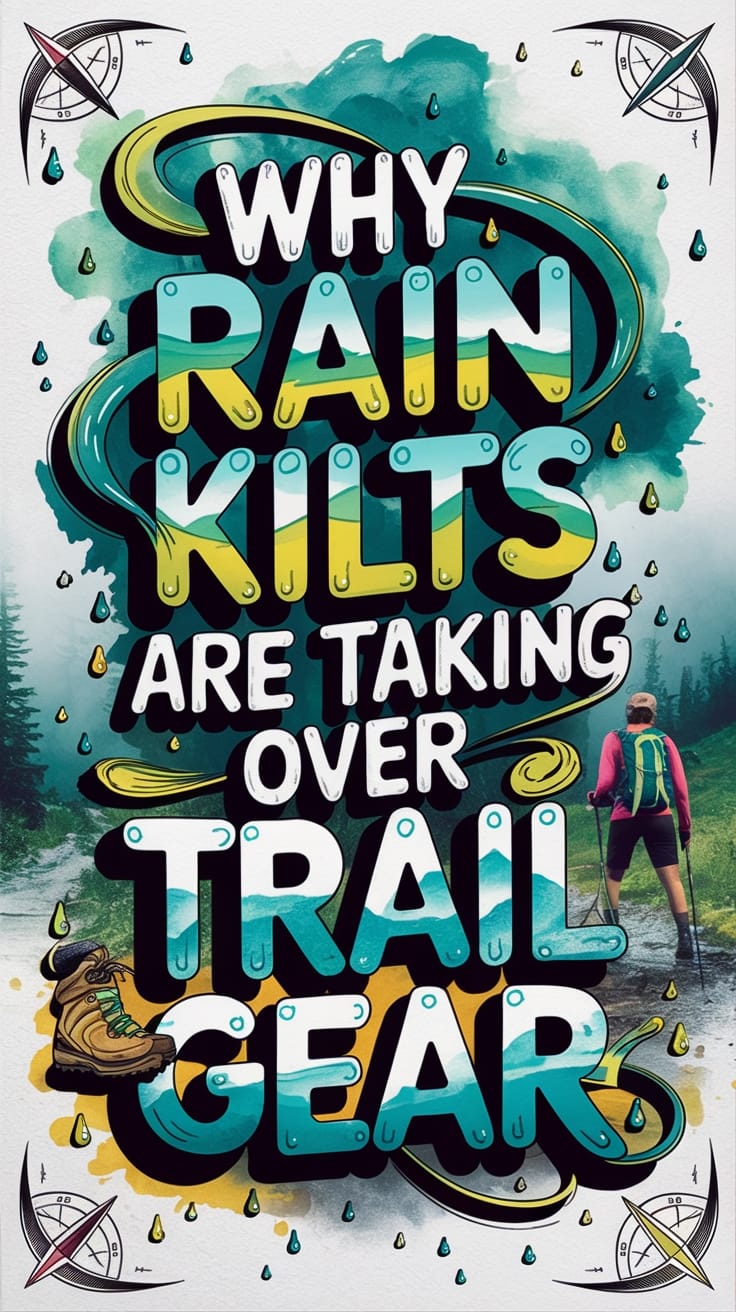Rain kilts are transforming trail gear with their ultralight design and unbeatable performance. You'll cut pack weight dramatically while gaining superior protection, with most models weighing under three ounces and crafted from high-tech fabrics like Sil-Nylon and Dyneema Composite Fabric. These versatile garments provide exceptional breathability, quick-change convenience, and multi-functional utility—serving as windbreakers, groundsheets, or emergency covers.
Hikers on renowned trails like the AT and PCT are praising their adaptability, with top brands offering adjustable fits and remarkable ventilation. They're perfect for moderate to warm climates, offering a lightweight alternative to traditional rain pants that'll keep you dry without weighing you down. Curious about the next-level trail innovation that's changing outdoor adventures?
Trail-Tested: Understanding Rain Kilts for Thru-Hiking

Ever wondered what a rain kilt is? It's an ingenious piece of outdoor gear that's revolutionizing how hikers stay dry on the trail. Fundamentally, a rain kilt is a waterproof, breathable skirt designed specifically for outdoor adventurers who want lightweight protection without the bulk of traditional rain pants.
Crafted from high-performance materials like silicon-impregnated nylon or ultralight Dyneera Composite Fabric (DCF), these innovative garments typically weigh between 2.8 and 5 ounces. They're engineered with smart features like elastic waistbands and Velcro tabs, allowing you to adjust the fit to your body, ensuring maximum comfort and flexibility throughout your outdoor adventures. ULA's specific rain kilt actually accommodates waist sizes from 28 to 50 inches, offering exceptional adaptability for diverse body types.
Unlike restrictive rain pants, a rain kilt offers superior ventilation and remarkable ease of movement. You'll appreciate how quickly you can slip it on and off, even without removing your boots – a game-changer when sudden mountain storms roll in. The Vertice Rain Kilt's waterproof fabric provides exceptional storm protection with its unique conical shape that allows for longer strides.
Its compact design means you can easily stash it in your backpack, with most models packing down to dimensions around 5.25" x 4" x 2.5".
Whether you're an ultralight backpacker or a casual day hiker, a rain kilt provides a versatile solution for staying dry without sacrificing comfort or mobility.

Base Weight Warriors: The Sub-3oz Rain Protection Solution

The lightweight revolution of rain kilts transforms outdoor gear performance with remarkable efficiency. You'll be amazed at how these innovative garments can dramatically reduce your pack weight, with most rain kilts weighing less than three ounces—a significant improvement over traditional rain pants. Mountain Laurel Designs offers the lightest options, with their rain kilt weighing just 1.7 ounces.
Advanced materials like Sil-Nylon and Cuben Fiber facilitate this incredible weight savings, often cutting up to 10 ounces from your hiking ensemble. Top models from brands like Zpacks and Enlightened Equipment demonstrate the cutting-edge materials and design innovations driving this trend.
Performance isn't sacrificed for weight, either. Rain kilts shine in moderate to warm climates, offering exceptional breathability and ventilation that keeps you comfortable when other rain gear would leave you sweltering. Their quick-on, quick-off design means you can adapt to changing weather conditions without breaking stride, with elastic waistbands and Velcro tabs ensuring a personalized fit.
The versatility of rain kilts extends beyond simple precipitation protection. They can serve as windstoppers, groundsheets, or even impromptu laundry covers.
While they don't provide full lower leg coverage—a minor trade-off—their lightweight construction, durability, and cost-effectiveness make them an increasingly popular choice among ultralight backpackers seeking smart, minimalist gear solutions that don't compromise on functionality.

Triple Crown Weather Strategies: Beyond Basic Rain Protection

With every step on the trail, hikers encounter potential risks that demand thoughtful preparation and strategic protection. Your rain kilt isn't just a lightweight gear piece; it's your first line of defense in a thorough trail safety approach. Staying on designated trails prevents ecosystem damage and minimizes potential disruption to delicate natural environments.
Ultralight rain gear like the ULA Rain Kilt provides strategic weight reduction while ensuring comprehensive protection against unexpected weather conditions.
Protection extends far beyond clothing, encompassing a holistic strategy that integrates environmental awareness and responsible hiking practices.
4 Critical Trail Protection Strategies:
- Wildlife Awareness: Maintain a safe distance from animals, observing without disrupting their natural habitat.
- Environmental Preservation: Minimize your impact by staying on designated trails and avoiding ecosystem disturbance.
- Gear Preparedness: Clean and maintain equipment to prevent spreading invasive seeds or pathogens between locations.
- Waste Management: Pack out everything you bring in, ensuring no trace of your presence remains.
Your rain kilt serves as more than weather protection—it's a symbol of your commitment to responsible outdoor exploration.
By integrating smart gear choices with mindful trail practices, you're not just protecting yourself but contributing to the broader ecosystem's preservation.
Each carefully thought-out step demonstrates respect for nature, wildlife, and the complex trail environments you're privileged to experience.
Why Thru-Hikers Are Making the Switch

Experienced hikers are finding that rain kilts represent more than just a trend—they're a strategic upgrade to traditional hiking attire. Significantly lighter weight compared to rain pants means hikers can reduce pack load without sacrificing protection.
With their durability, high visibility choices, and remarkable comfort, these ultralight protection solutions are quickly becoming a must-have for serious trail adventurers seeking smart, efficient gear.
Breathable design allows hikers to stay cool and dry, preventing overheating during dynamic trail conditions.
Trail-Tested: Rain Kilts vs Traditional Rain Pants on the AT
Comparing traditional rain gear reveals a nuanced environment of protection for hikers traversing diverse trail conditions. When you're selecting waterproof equipment, understanding the pros and cons of rain kilts versus rain pants becomes essential for your outdoor adventures.
Your trail experience depends on making informed gear choices, and here's why rain kilts might transform your hiking approach:
- Lightweight Performance: Rain kilts typically weigh under three ounces, dramatically reducing pack weight compared to traditional rain pants.
- Superior Ventilation: Open designs prevent overheating in moderate to warm climate hiking.
- Quick Adaptability: Easy on-and-off functionality over hiking boots makes rain kilts incredibly convenient.
- Cost-Effective Solution: Generally more affordable than specialized rain pants from brands like Gore-Tex or Mountain Hardwear.
The ultralight fabric technology in modern rain gear allows manufacturers to create incredibly lightweight and breathable protective layers that challenge traditional rain gear design. Moisture management strategies play a crucial role in determining the effectiveness of rain gear for long-distance hikers.
Rain kilts aren't always a universal solution. They falter in cold, windy environments and provide minimal protection for lower legs.
Rain pants remain superior for multi-season use, especially in freezing rain or snow conditions. Your specific trip's climate, personal comfort preferences, and packing constraints will finally determine the ideal rain gear.
Consider your terrain, expected weather patterns, and individual hiking style when making this vital equipment decision.
Ultralight Materials: From AT to PCT-Approved Designs

As hikers seek lighter, more adaptable rain protection, manufacturers have responded with innovative materials and design breakthroughs in rain kilts.
Top brands like Zpacks, ULA, and Mountain Laurel Designs are revolutionizing outdoor gear with ultralight fabrics such as Dyneema Composite, Cuben Fiber, and Silicone Impregnated Nylon, each offering unique performance characteristics that dramatically reduce weight and enhance mobility.
| Material | Weight | Breathability |
|---|---|---|
| Dyneema | 2 oz | High |
| Sil-Nylon | 3 oz | Moderate |
| 3L Vertice | 2.5 oz | Superior |
Design innovations have transformed rain kilts from simple protective layers into sophisticated trail gear. Full-length zippers provide easy ventilation, while elastic waistbands and adjustable Velcro tabs guarantee a personalized fit.
The split center design offers unprecedented versatility, allowing you to quickly adapt to changing weather conditions.
Whether you're traversing coastal trails or working in unpredictable environments, these ultralight rain kilts represent a quantum leap in outdoor protection, combining breathability, rapid deployment, and minimal weight into a single, elegantly engineered solution that'll keep you dry without weighing you down.
Thru-Hiker Packing Tips: Strategic Rain Protection
Trail-savvy hikers understand that efficient rain kilt storage can make or break a wilderness adventure. Your packing strategy can transform a potentially miserable wet trek into a comfortable journey, especially when you've got a ULA Rain Kilt that packs down to the size of a dollar bill.
These ultralight wonders aren't just about protection—they're about smart, minimalist outdoor preparation.
Consider these essential storage techniques:
- Pocket Placement: Stash your rain kilt in easily accessible side pockets or pant compartments for lightning-fast deployment.
- Multipurpose Planning: Use your kilt as both rain protection and an impromptu groundsheet, maximizing gear utility.
- Weight Consciousness: Choose kilts that weigh dramatically less than traditional rain pants, preserving your pack's precious weight allowance.
- Versatile Deployment: Select designs with elastic waistbands that accommodate quick changes without removing shoes.
Your rain kilt isn't just gear—it's a strategic solution for unpredictable trail conditions.
The ultralight philosophy isn't just about reducing weight; it's about enhancing your hiking experience through intelligent, adaptable equipment choices.
Trail Based Insights: 2,000+ Mile Rain Kilt Reviews

Amid countless miles traversed across diverse terrains, hikers have discovered that rain kilts aren't just another piece of gear—they're a transformative solution for staying dry and comfortable. Trail veterans from the Appalachian Trail to the Camino de Santiago have consistently praised the ULA Rain Kilt for its remarkable performance in challenging conditions.
| Trail | Experience | Rating |
|---|---|---|
| AT | Excellent breathability | 4.5/5 |
| PCT | Quick-dry functionality | 4.3/5 |
| CDT | Lightweight protection | 4.7/5 |
| Camino | Versatile in varied conditions | 4.6/5 |
Hikers universally appreciate how these lightweight garments solve multiple challenges simultaneously. They've found rain kilts excel in warmer environments where traditional rain pants cause uncomfortable overheating, providing superior ventilation without sacrificing protection.
While acknowledging limitations like reduced lower leg coverage, most users emphasize the kilt's incredible ease of use—you can slip it on mid-hike without removing your pack or shoes.
Performance testimonials highlight durability and unexpected benefits, such as mud protection amid accidental falls. Whether you're a thru-hiker or weekend warrior, rain kilts represent a smart, adaptable solution for unpredictable trail conditions, proving that sometimes less truly is more in outdoor gear design.
Choosing Your Thru-Hike Rain Kilt
- Fit and Flexibility: Look for adjustable waistbands, elastic closures, and designs that allow maximum mobility, ensuring you're not restricted in challenging hiking moments.
- Weight Considerations: Aim for ultralight options between 1.8 and 2.8 oz, which provide protection without adding unnecessary bulk to your pack.
- Budget and Versatility: Expect to invest $45 to $80 for a quality rain kilt that can double as a groundsheet, modesty cover, and essential trail protection.
Your perfect rain kilt will ultimately hinge on your specific hiking style, terrain, and personal comfort preferences, making careful selection vital for your outdoor adventures.









